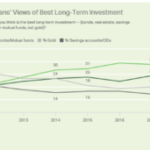While there are numerous ways to short Treasuries, there are several different approaches investors choose to take, each suited to a particular strategy and risk tolerance. What I’m outlining today is both high-risk and highly likely to succeed – IF I can outlast the Fed. See, I entered into the ultimate risk short today that I’ll describe further below, but want to emphasize that this probably isn’t a prudent approach for most retail investors and requires the ability to short, a margin account, and intestinal fortitude.
Short Treasury Strategy
The approach I took was to combine the leverage that options offer, the poor performance of leveraged ETFs over time (see more on ETF Decay), and the time value decay of both options and leveraged ETFs.
- Sold TMF Calls (TMF was priced at 61 during Tuesday trading)
- Strike Price $75
- Expiry November
- Premium 3.40 each
TMF is the 3X leveraged 30-Year Treasury Bond ETF from Direxion. This is about as turbo-charged as you can get in looking to short bonds. In the past, I’ve already sold TMF short as an ETF holding, but now I’ve turbocharged the play even further.
Here’s the Rationale:
- Treasury Yields are already at historic lows. Can they go lower? Of course, Bill Gross was wrong months ago. But I have breathing room. Yields would have to continue to drop appreciably – and quickly.
- Most options expire worthless. This is true of the majority of option contracts written. The $75 strike is appreciably out of the money to make this a feasible outcome. Granted, the 3X leverage doesn’t put $75 very far from Tuesday’s close at $61. But that’s a pretty rapid move from an already generational low in yields.
- To put this into perspective further, we’re really talking about $78.40 before I even lose a dime due to the time premium (the $340 I collected upon sale).
- I have other short positions in my portfolio, so for long bond yields to continue to tank, it would probably take some sort of exogenous event or major market malaise, which would translate into gains elsewhere in the portfolio.
- On the personal finance side, the lower long bond yields go, the more attractive mortgage rates become. I’ve been considering another refi (after I thought I’d never have to again) because mortgage rates are incredible at these rates and a further decline in the 10-30 year maturities could push 15 and 30 year mortgages into an area where my NPV is well above $10,000 just for refinancing yet again, more than offsetting a loss of a few hundred or even a few thousand dollars in this position.
- This is an income investment of sorts. While there are very few safe high yield investments remaining in this new era of zero Fed funds rates, deriving income from stock options while volatility remains high is certainly an income investing strategy worthy of consideration.
Here’s What Can Go Wrong:
- Quite a bit. First off, these are open, “naked” calls I sold. So, I have unlimited exposure to loss. Not only could this become quite costly, but it also mangles up my margin requirements and could force me to either close this position earlier than desired or sell off other assets to keep it going. You can always compare savings accounts for a much safer play, and this is not for the faint of heart.
- The way leveraged ETFs work, if a trend doesn’t break, the 3X ETF can track pretty close to 3 times the movement of the underlying index. This runs contrary to what normally happens, where the decay I outlined above takes hold for flat or mild trends and a 3X ETF ends up losing money no matter what the underlying index does. But a look back at TMF over the prior 6 months shows an 85% gain, so being short another 85% could be quite painful.
Disclosure: Short TMF via naked call options.










{ 1 comment… read it below or add one }
According to Zero Hedge, countries outside of the U.S. dumped 74 billion dollars in U.S. Treasuries, most of it over the weekend:
“Over the weekend, we observed the perplexing sell off of $56 billion in US Treasurys courtesy of weekly disclosure in the Fed’s custodial account (source: H.4.1) and speculated if this may be due to an asset rotation, under duress or otherwise, out of bonds and into stocks, to prevent the collapse of the global ponzi (because when the BRICs tell the IMF to boost its bailout capacity you know it is global). We also proposed a far simpler theory: “the dreaded D-day in which foreign official and private investors finally start offloading their $2.7 trillion in Treasurys with impunity (although not with the element of surprise – China has made it abundantly clear it will sell its Treasury holdings, the only question is when), has finally arrived.” In hindsight the Occam’s Razor should have been applied. Little did we know 5 short days ago just how violent the reaction by China would be (both post and pre-facto) to the Senate decision to propose a law for all out trade warfare with China. Now we know – in the week ended October 12, a further $17.7 billion was “removed” from the Fed’s custodial Treasury account, meaning that someone, somewhere is very displeased with US paper, and, far more importantly, what it represents, and wants to make their displeasure heard loud and clear. (Source)
Undoubtedly, the Chinese and other countries have recently discovered that Italy and Greece, with smaller debt to income ratios than the United States, are less riskier and carry a higher rate of return. This is because, unlike the US, the Rothschild/Rockefeller bond rating agencies have trashed their country’s debt ratings, forcing them to pay a much higher interest rate than U.S. Treasuries. Hey, if you take the risk, you might as well earn the reward!
{ 3 trackbacks }